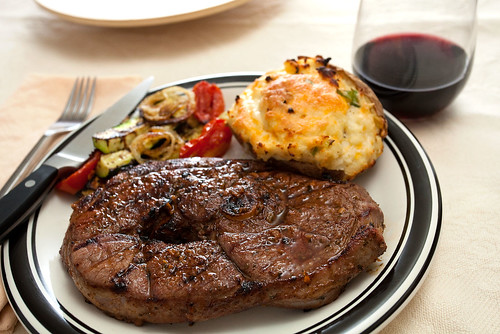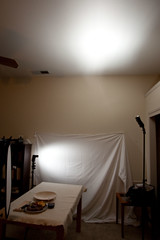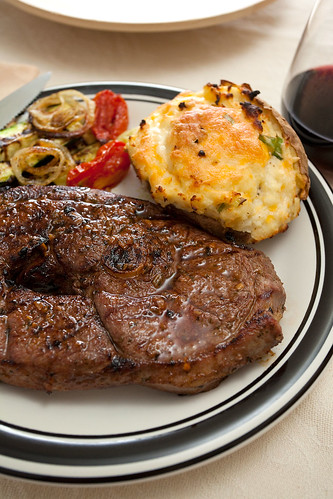I think this was the first shoot where we actually sat down and planned the meal for the shoot. We decided to go with some grilled zucchini, tomatoes and onions to provide some color contrast on the plate and some cheese-covered twice-baked potatoes to provide some alternate mass on the plate.
I also started to get more serious about props to fill in the empty spaces in the frame, using a wine glass and bamboo platter to anchor areas at the top of the frame. It actually works pretty well, and the food doesn't look quite so alone in the frame.
The lighting was simple. I wanted to try to get that directionless high key lighting that is so popular today, but that requires very large light sources. I have two small flashes. So, I pointed them at the largest white surfaces I have: the wall and the ceiling.
I wanted to retain the specular highlights that I knew would appear on the juicy steak, so pointing the one flash at the wall would provide relatively soft light, but with enough focus to give me attractive highlights.
Overall this worked pretty well, but there isn't anything really special about these images. The lamb, however, was incredible.
Lessons Learned
- In certain situations, I'm beginning to be able to predict the effect of lighting
- Planning the shoot helps, but we still need to work on our communication
- This lighting worked OK, but I need to be flexible in the middle of a shoot to change the lighting if its not working. The rush of getting the food photographed before it gets cold tends to limit my creativity.
- Just adding the corner of an empty plate in the background can really help to fill in an image and build interest. Take the extra second to place something in that empty corner of the image.
- Stemless wine glasses can fit into a limited space in a photo where you would only see the stem of a regular wine glass.



No comments:
Post a Comment